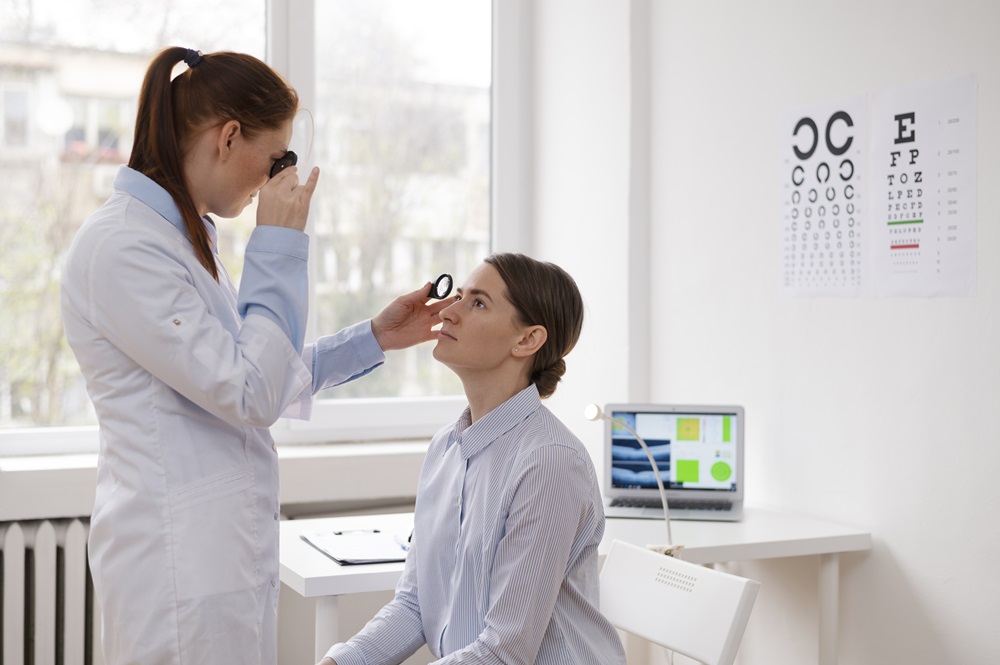
Last Updated on July 1, 2025 by Aaron Barriga
Genes play a crucial role in determining various aspects of our health, including vision and eye health. Our genetic makeup can influence the likelihood of developing certain eye conditions.
According to the World Health Organization, around 2.7 billion people worldwide are affected by uncorrected poor vision, with an estimated 2.2 billion suffering from blindness or visual impairment. Understanding the connection between genetics and eye health is essential for both prevention and treatment strategies.
The Role of Genetics on Vision
Our genetics are the blueprint of our eyes. All the information that our genes carry determines every aspect of our eyes, including shape, color, and the way they function. Here’s a little more in-depth on how genetics shapes our vision in different aspects:
1. Eye Color
The color of your eyes is shaped by the unique combination of genes you inherit. While brown eyes are the most common since they tend to dominate, there’s still a chance you might get a different eye color if one of your parents has lighter eyes.
This is due to the intricate way genetics work. Two specific genes, OCA2 and HERC2, play a big role in deciding your eye color, though the process is far more complex than it seems at first glance.
Also Read: Color Vision Deficiency: Types, Causes, and Treatment
2. Eye Size and Shape
The shape and size of your eyes also depend on genetics. The genes SH3PXD2 B, AXL, and PAX6 are involved in shaping the decision of your eye size and shape.
3. Vision Capabilities
Your genes also influence how sharp your vision is. Conditions like nearsightedness or farsightedness often run in families and are passed down from one generation to the next. Scientists have pinpointed several genes, such as GJD2 and RASGRF1, that are linked to these vision issues.
4. Eye Health
While your eye health depends on the way and extent to which you take good care of it, you cannot escape the fact that genes are also responsible for making you vulnerable to several eye conditions. These may include making you more prone to developing eye conditions such as macular degeneration, glaucoma, and retinal degeneration.
9 Common Hereditary Eye Conditions
While several eye problems are influenced by our lifestyle and the environment, some are linked to hereditary. Let’s dive into the list of common genetic eye conditions:
1. Myopia (Nearsightedness)
Myopia, also known as nearsightedness, is an eye condition that makes it difficult to see objects at a distance. It is said to run in families, suggesting that genes play a strong role. So, if your parents have myopia, you are more likely to develop it.
2. Hyperopia (Farsightedness)
Hyperopia, also known as farsightedness, is an eye issue where you cannot see things close to you. Similar to myopia, hyperopia can also be inherited. If your parents have this eye condition, you are more vulnerable to developing it.
Read more: Nearsightedness vs. Farsightedness
3. Astigmatism
Astigmatism, a condition where the cornea has an uneven shape, often leads to blurry vision and can be inherited. If one or both of your parents have it, there’s a high likelihood you might experience it too.
4. Amblyopia
Amblyopia, commonly known as lazy eye, is an eye development disorder where abnormal development occurs in your vision. This can be seen in early childhood. A lazy eye develops when the brain doesn’t get the proper stimulation from the eyes, causing it to rely more on one eye than the other. Essentially, the nerve cells involved in vision don’t grow as they should, leading to this condition.
5. Glaucoma
Glaucoma occurs when the pressure inside the eye rises, damaging the optic nerve and leading to a loss of peripheral vision. While it’s often associated with older adults, it can also affect infants and young people. Early-onset glaucoma can follow different genetic patterns. Congenital glaucoma, which appears at or around birth, is typically inherited as an autosomal recessive trait. This means both copies of the gene in each cell carry a mutation, although the parents usually don’t display any symptoms themselves.
6. Cataracts
A cataract is a clouding of the lens inside the eye, which blocks light from entering and results in reduced vision. While cataracts are most common in older adults, they can also be present at birth (congenital cataracts), develop during childhood or adolescence (juvenile cataracts), or occur in younger adults. They may also form after an eye injury, surgery, inflammation, or as a side effect of certain medications.
7. Age-Related Macular Degeneration (AMD)
Age-related macular degeneration (AMD) impacts the macula, the area of the retina responsible for clear, central vision, and is a major cause of vision loss in older adults. Early signs include blurry or distorted vision, along with trouble recognizing faces.
8. Retinitis Pigmentosa
Retinitis pigmentosa (RP) isn’t just one condition; it encompasses a group of related disorders that lead to gradual vision loss due to retinal degeneration.
Typically, the first noticeable symptom in childhood is a decline in night vision. As the condition advances, blind spots emerge in peripheral vision, gradually expanding and leading to tunnel vision.
Eventually, the central vision can also be compromised. Various gene mutations are responsible for the different forms of RP, but they all result in the same outcome: retinal degeneration.
9. Color Blindness
Color blindness, or color vision deficiency, is marked by difficulty in distinguishing between different colors. The human eye perceives color through specialized cells in the retina known as cones, which come in three types—each sensitive to red, green, or blue light.
The main cause of color blindness is an abnormality in the light-sensitive pigments within these cones. Since this condition arises from genetic variations, it is present at birth and currently has no cure.
What Can You Do if You Have a Family History of Eye Conditions?
Now, having eye conditions run in your family does not necessarily mean you will develop them. But if you have a history of eye conditions, you need to take great care and necessary preventive measures to reduce your risk of developing them. Here are some measures to take:
1. Regular Eye Checkups
A key strategy for managing eye conditions with a genetic link is to schedule regular eye exams. These check-ups can help identify potential issues early on before they lead to significant vision loss. If you have a family history of eye problems, your doctor may suggest more frequent examinations.
At InSight Vision Center, our comprehensive eye exams are designed to detect a range of conditions early, ensuring you receive the best possible care. Don’t wait—schedule your appointment today at InSight Vision Center!
2. Healthy Lifestyle
Embracing a healthy lifestyle can significantly lower your chances of developing eye issues. This involves maintaining a nutritious diet, staying active through regular exercise, and steering clear of smoking and heavy drinking. These habits can help prevent new eye conditions and aid in managing existing ones, like age-related macular degeneration and glaucoma, while minimizing the risk of complications.
3. UV Protection
Shielding your eyes from harmful UV rays is essential for lowering the risk of various eye conditions. So, whenever you’re outside, make sure to put on sunglasses that offer complete UV protection. Your eyes will thank you for it!
4. Genetic Counseling
Genetic counseling can be a valuable tool in pinpointing the risk of specific eye conditions even before symptoms arise. This approach is especially beneficial for conditions like glaucoma and age-related macular degeneration, where catching the problem early can lead to effective treatment and greatly enhance your chances of preserving your vision.
Modern Eye Care Solutions: LASIK and More
In modern ophthalmology, LASIK eye surgery stands out as a premier solution for various vision impairments, including myopia, hyperopia, glaucoma, and cataracts. This advanced procedure offers a remarkable opportunity for individuals seeking clear vision without needing glasses or contact lenses.
At InSight Vision Center, patients can expect comprehensive consultations and personalized care, ensuring that each individual receives the best treatment tailored to their specific needs.
The LASIK procedure at InSight Vision Center utilizes cutting-edge technology and skilled professionals to provide safe and effective results. With a focus on our patients’ comfort and satisfaction, we offer a welcoming environment where expert staff guide them through every step of the process.
If you’re ready to explore how LASIK can transform your vision, visit InSight Vision Center today to learn more about this life-changing procedure.

Dr. Azhar I. Salahuddin is an ophthalmologist and is fellowship-trained in cornea, external diseases, and refractive surgery. Dr. Salahuddin has been performing cataract surgery for over 19 years and specializes ocular reconstruction, corneal transplantation surgery as well as vision correction through a variety of intraocular lenses. Dr. Salahuddin is board-certified by the American Board of Ophthalmology and was trained at Boston University.

